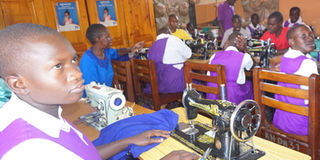Skills making children with special needs independent

Some of the pupils in a tailoring class at Kireka Home for Children with Special Educational Needs. These skills help the children to be self-reliant. Photo by Desire Mbabaali
What you need to know:
Gone are the days when children with special needs would be abandoned in homes as their siblings go through school. At Kireka Home for Children with Special Educational Needs, children go through vocational to help them be self-reliant.
Walking into Kireka Home for children with special educational needs, one is welcomed by a couple of students standing at the school gate, looking on with anxious but welcoming faces.
When I eventually say hello to them and enter the head teacher’s office, I am followed by curious looks, like they were suspicious of my presence.
This is a government-aided boarding school and has been in existence for the past 34 years. It is home to more than 81 children with special needs.
In a bid to understand how teaching and learning takes place at the school, Patrick Osiru, the head teacher, explains that, “Our emphasis lies on practical skills training so that we help these children to be self-reliant. We think about a time when they will not be with us, when they are back in their communities and how they will survive.”
They, therefore, operate on a modified curriculum set by the National Curriculum Development Center (NCDC), which focuses on vocational activities such as; tailoring, cookery, poultry, general crafts, urban agriculture, and elementary academics which includes subjects like scribbling, pre reading, mirror writing, and a little numeracy. “We groom each pupil according to their interests,” Osiru notes.
Dividing learners
Due to difficulties in communication, we never got chance to talk to any pupils, however, as they sat in their different classrooms, some seemed absorbed in their work, others obviously uninterested while others where relatively distracted by the presence of a visitor.
The school is divided into six ability groups (classes) and has six learning areas and pupils of different ability groups learn on a rotational basis.
Christine Mafabi, an instructor in ability group six (G6), which is also the highest group/class at the school shares, “From ability group one, the emphasis is on vocational subjects and gradually, pupils’ abilities are developed throughout the classes. Here (G6), we do sewing, cookery, knitting and weaving,” she says.
Among the items made are scarves - since they are easy to make, shorts, small dresses, money purses, casual bags, minor repairs on uniforms and other garments. In weaving, pupils make doormats, bedside mats, table mats, casual bags, baby bags, beaded bracelets and necklaces, among other items.
“We normally keep to the simple things because students always shun difficult tasks but also because of their low attention span, the do not spend a lot of time on one item. We instruct them for about 30 minutes and resume in the evenings. Again, something must be done repetitively overtime for them to understand it. So, they are not very perfect, but with time and attention, they learn,” Mafabi says.
Assessment
In tracking their progress and determining promotion from one group to another, the school has a panel of teachers who assess the children and determine which ability group they should belong,
“However, each teacher assesses the child at the end of the year coupled with daily checks. Through that assessment, we are able to even prepare their reports. We do not give exams, but we track progress, by seeing how well they do things, where they are lacking and teach them accordingly,” Mafabi notes.
Sylvia Namagembe, the deputy head teacher and group one teacher, where pupils with more severe conditions are handled, says for some children, learning self-help skills such as brushing, bathing, toilet training or being able to handle things such as a pencil and scribble something down, is enough progress to have them move to the next level. “Some of them may not go beyond where they are because of their ability. Again, there is no specific period of stay but what matters to us is what somebody has achieved,” Osiru notes.
Therefore, once a child has excelled in mastering a skill in a particular section, the school sits their parent down and makes recommendations and the parent can decide to either receive the child back into the community or let them stay in school. “Hand in hand with the parent, we organise a resettlement package for the child. For example, if they have excelled in tailoring, we organise and buy for them a sewing machine and graduate them,” Osiru explains.
Like the teachers say, instead of neglecting children with special needs, enroll them in schools that pay attention to their learning abilities. “When you have a special needs child, do not lose heart. Pick up the pieces, bring your child so that we equip them with a skill to help them later when you are not there,” Mafabi encourages.
Benefits
The biggest joy for teachers at Kireka Home for children with special educational needs is seeing a child who could not do anything for themselves be able to do something, even the little things. “More emphasis is put on vocational skills because most of the children in our area for example can be able to earn a living out of that so they are not totally dependent on their parents,” Namagembe says.
Challenges
Juliet Namanda, the class teacher group six at Kireka Home for children with special educational needs, notes that the biggest challenge is communication since many students have speech impairments. “Sometimes we just guess what they mean, and sometimes we they signal for us what they need,” she says. Namagembe, however, notes that teaching these children is not difficult, when you have the interest and passion.




